St. Louis Flat Roof Replacement
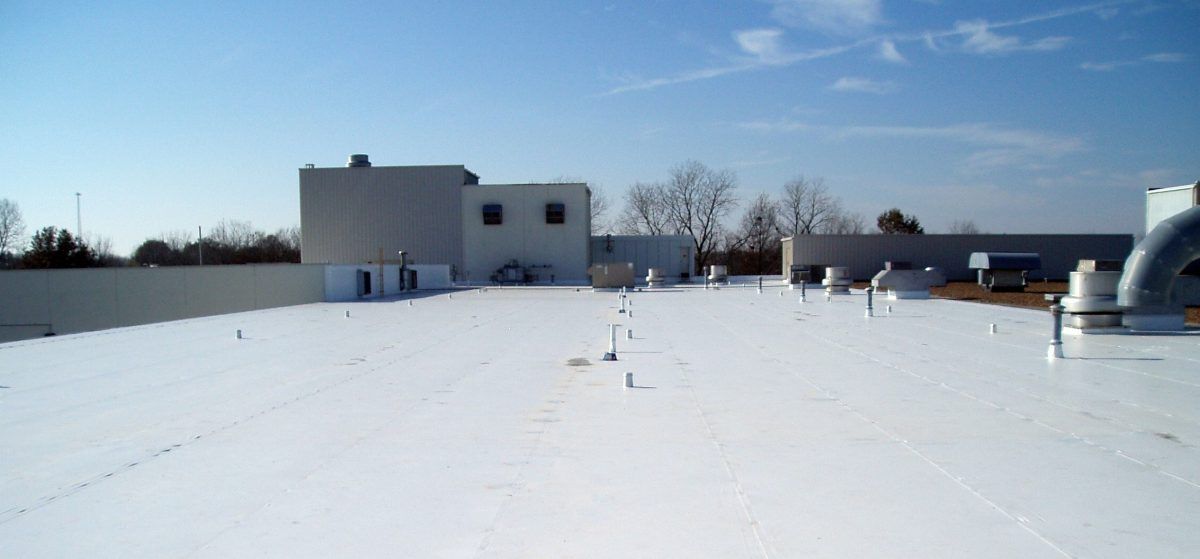
The majority of commercial roofing services feature a flat roof on top of them. The term flat roof is actually a bit of a misnomer since any correctly installed flat roof solution will employ a very low slope that facilitates the water draining off of the roof. Some incorrectly installed systems do not allow the water to drain off of the roof, and small ponds can form, sometimes lasting many days.
The nature of a flat roof is that Rainwater does not drain as rapidly from it as it does from, say, a shingle roof. That extended contact means that water has a great chance of finding any small nook or imperfection in the roof and leaks inside the building. At Jewett Roofing, we realize that the highest quality materials must be used, and special attention to detail is required in order to ensure that the rain stays out in the building and the inside stays dry.
Flat Roof Materials Offered by Jewett Roofing
-
- PVC – A tried and true flat roofing performer. PVC has been protecting rooftops for almost 50 years. Jewett Roofing proudly installs Duro-Last.
- EPDM—Sometimes called “rubber roofs, “EPDM remains very flexible well into its lifetime and offers superior impact resistance compared to other types of roofing. Jewett Roofing is licensed to install Genflex and Versico EPDM roofs.
- TPO – A relative newcomer to the flat roofing scene, TPO is one of the fastest-growing segments of the commercial roofing market. Jewett Roofing installs Versico and Genflex TPO roofing systems.
Modified Bitumen – Having the appearance of wide rolls of shingle material, modified bitumen is an excellent choice where roof traffic and wear are a consideration. Jewett Roofing is an authorized installer of Soprema-modified bitumen roof systems. - Liquid-Applied Coatings—An excellent alternative to a new roof, coatings extend the life of your existing system. ER Systems, Everest, and 838 Coatings are all available from Jewett Roofing.
Learn More About Your Roof Here:
PVC Roofing
PVC roofing is a long standing and proven performer in the field of single-ply roofing.
PVC Roofing Solutions
PVC stands for Polyvinyl Chloride. When you hear PVC you might think of PVC piping like that which is used in plumbing. PVC roofing membrane is not rigid like PVC piping, instead manufacturers add plasticizers, stabilizers, and other additives to keep the roof membrane pliable and durable. The membrane is reinforced with a woven scrim laminated between two sheets of membrane. The quality and type of scrim varies by manufacturer.
PVC membrane is often manufactured in rolls ranging from 6 to 12 feet wide. Which is then attached to the roof deck and heat welded together. This creates a single continuous sheet of membrane that covers the whole roof.
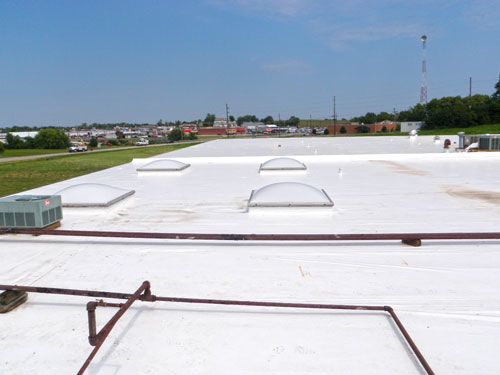 Some companies, such as the Duro-Last Roofing Company, pre-manufacture these rolls into larger sheets which are designed to fit the individual roofing project.
Some companies, such as the Duro-Last Roofing Company, pre-manufacture these rolls into larger sheets which are designed to fit the individual roofing project.
This custom fabrication approach reduces the amount of labor required to attach the membrane and also reduces the chance for an improper weld by the roofing contractor.
Fleece Backed PVC membrane is manufactured with a non-woven fleece backing applied to the underside of the sheet. It is typically then adhered to the roof substrate.
Pros:
Long Track Record, Watertight regardless of ponding, Available in a variety of colors, Excellent reflectivity.
Cons:
Impact resistance diminishes with age
Learn More About Your Roof Here:
TPO Membrane
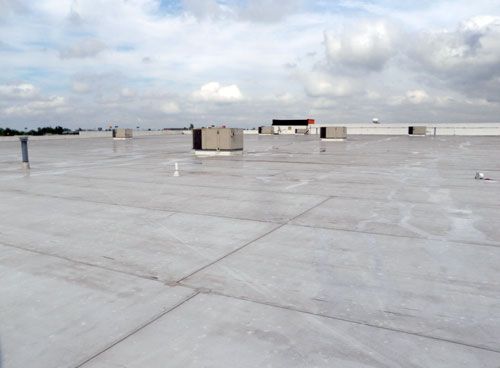 A relative newcomer to the field single ply roofing: TPO or Thermoplastic Polyolefin, has been around since the late 1980’s.
A relative newcomer to the field single ply roofing: TPO or Thermoplastic Polyolefin, has been around since the late 1980’s.
TPO membranes are produced by calendering with lamination, extrusion with lamination, or extrusion-coating techniques. TPO sheets are a blend of polypropylene and ethylene propylene polymers and usually are reinforced with polyester scrim. TPO sheets contain colorant, flame retardants, UV absorbents and other proprietary substances to achieve desired physical properties.
Early formulations of TPO had reports of accelerated decomposition of the membrane in areas where additional sunlight would reflect off a surface onto the TPO. However, many manufacturers insist that either their membrane never suffered from these issues or their formulation has been altered to alleviate the problems.
TPO Membranes are fastened in one of 3 ways:
- Mechanically fastened assemblies rely on rows of screws or nails to secure the membrane to roof deck.
- Fully Adhered assemblies use special glues to ensure the membrane stays stuck tight to the insulation.
- Loose laid assemblies are not fastened to the roof deck but rather are covered in smooth river rock whose weight ensures the membrane does not blow away.
Pros:
Reflective Surface, Available in a variety of colors
Cons:
Shorter Track Record than PVC or EPDM
Learn More About Your Roof Here:
EPDM Roofing
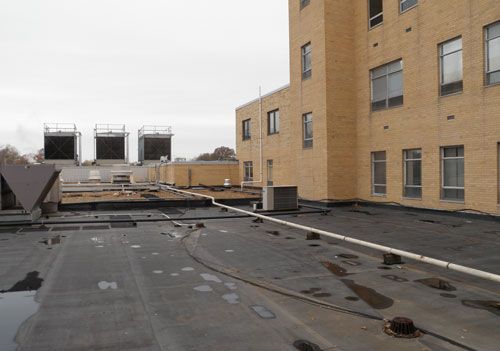 This is the oldest type of single ply roofing, which remains widely in use today and has had consistent formulations for the last 40 years or so. These types of roofs are often referred to as rubber roofs, as they have a similar appearance to a rubber tire inner tube.
This is the oldest type of single ply roofing, which remains widely in use today and has had consistent formulations for the last 40 years or so. These types of roofs are often referred to as rubber roofs, as they have a similar appearance to a rubber tire inner tube.
EPDM – Industrial Rubber Roofing
EPDM or commonly referred to as a “Rubber roof” is a very popular roofing system throughout the country. They may installed by one of three methods: fully adhered with an adhesive, ballasted or held down by rock, or by being mechanically attached with screws and plates.
EPDM stands for ethylene propylene diene monomer. It is an elastomeric compound with ethylene and propylene are the two main ingredients which are derived from oil and natural gas. There are only small amounts of diene monomer. These ingredients are synthesized to produce a product that exhibits a high degree of ozone, ultraviolet, weathering and abrasion resistance, and provides outstanding low-temperature flexibility.
Sheet widths range from 7.5 feet to 50 feet wide and are typically 45 mils and 60 mils thick. Mechanically fastened assemblies rely on rows of screws or nails to secure the membrane to the roof deck. Fully Adhered assemblies use special glues to ensure the membrane stays stuck tight to the insulation. Loose laid assemblies are not fastened to the roof deck but rather are covered in smooth river rock whose weight ensures the membrane does not blow away. EPDM seams are typically sealed with a roof cement compound. However, some manufacturers market self-sticking sheets with the adhesive pre-applied to the membrane.
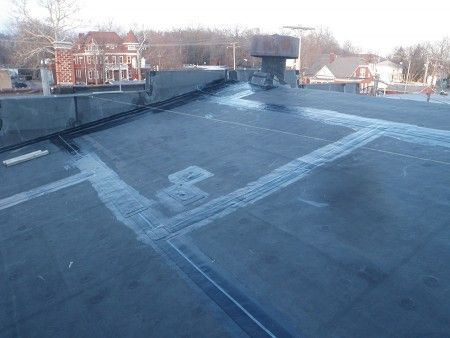 Pros:
Pros:
Durable, Resistant to Impact, Long Track Record
Cons:
Absorbs Heat, Prone to Shrinkage Near End of Life
EPDM Repair
EPDM Weaknesses:
- Seam failure
- Curbs and Penetrations
- Membrane shrinking and pulling away from edges and penetrations
Learn More About Your Roof Here:
Modified Bitumen
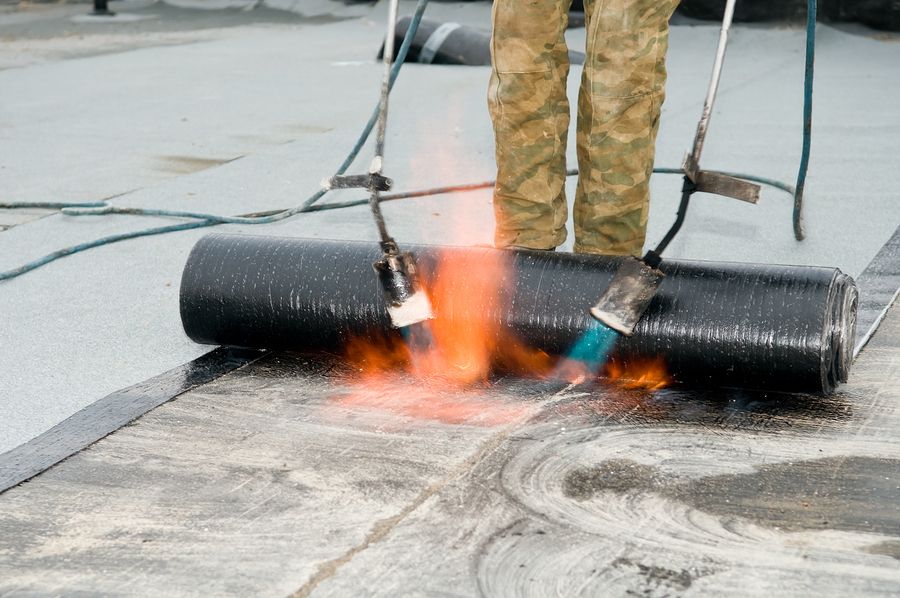
Modified bitumen is a durable roofing system option for flat roofs. It is flexible; expanding and contracting with temperatures, while maintaining weather resistance. It is easy to repair and install. It does not have gravel surfacing – making maintenance and repairs a much easier task. Although its surface typically does not require coating (reduced maintenance costs), an addition of coating may add years to the lifespan of the roofing system.
In the current manufacturing process of modified bitumen, there are two main modifiers that are added: APP (attactic polypropylene) and SBS (styrene-butadiene-styrene), increasing the flexibility and aging ability of the membrane, respectively.
Pros
- Common flat roofing system
- Asphalt with added modifiers, giving it a rubber-like quality
- Surfacings can include mineral granules, copper, aluminum, or aggregate
- Usually 1, 2, or 3-ply systems
Cons
- Applied with by torch down (which means it is more likely to experience leaks when the proper moisture barrier is not installing underneath the coping cap on parapet walls
- Other problems: inadequate head laps & backwater laps (allow moisture infiltration)
(Even cold-applied modbit systems (or ones with under-applied adhesive) can result in moisture infiltration.
Modified Bitumen Repair
Modified Bitumen is a long standing product in the commercial roofing market. MODBIT, when properly installed, can be an excellent roofing system providing years of performance. However, poor and inconsistent installation methods can often result in poor performance. MODBIT may see failure due to its susceptibility to hail, blistering from poor installation, and deterioration of the material due to ponding water.
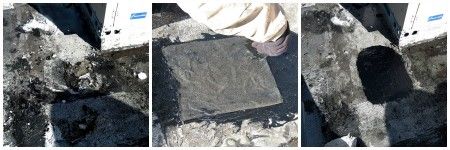 MODBIT Weaknesses:
MODBIT Weaknesses:
-
- Hail susceptibility
- Blistering from poor installation
- Deterioration due to ponding water
- Seam failure
Learn More About Your Roof Here:
Commercial Roof Coatings
What are Commercial Roof Coatings?
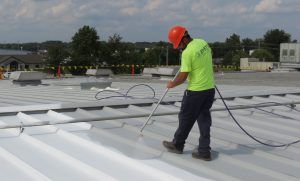 Roof coatings can be a great way to extend the life of your roof . Coatings are not considered a roof system in and of themselves, rather they serve to extend the usable life of an existing roof system such as metal, EPDM, MODIFIED BITUMEN, TPO, PVC, or built-up roofs. A roof coating is a liquid material that is applied to the roof surface either by spray or by roller which enhances the ability of existing roof system to both shed rain and resist causes of roof deterioration such as UV radiation and heat. There are many types of roof coating available on the market. Jewett roofing specializes in a class of coating known as polymer-based roof coatings. We specialize in acrylic and silicone coatings.
Roof coatings can be a great way to extend the life of your roof . Coatings are not considered a roof system in and of themselves, rather they serve to extend the usable life of an existing roof system such as metal, EPDM, MODIFIED BITUMEN, TPO, PVC, or built-up roofs. A roof coating is a liquid material that is applied to the roof surface either by spray or by roller which enhances the ability of existing roof system to both shed rain and resist causes of roof deterioration such as UV radiation and heat. There are many types of roof coating available on the market. Jewett roofing specializes in a class of coating known as polymer-based roof coatings. We specialize in acrylic and silicone coatings.
What’s In a Coating?
A binder is the substance that bonds all the other components of the roof coating together. Roof coatings are usually classified by the type of binder used in the coating. Acrylic and silicone are examples of binders used in roof coatings typically applied by Jewett Roofing.
Pigments are the materials within the coating that give the coating its characteristic color. Titanium dioxide is a very common pigment used to enhance UV resistance.
Fillers are materials in the roof coating that serve no other purpose than to provide bulk and weathering surface to the coating.
Modifiers are materials or chemicals added to the roof coating designed to give the roof coating a specific properties such as enhanced adhesion, viscosity, or durability.
The carrier is the liquid portion of the coating. The carrier evaporates from the coating once applied to the roof leaving behind the solid roof coating. Coatings are typically either water-based or solvent-based depending on the coating and it’s desired use case.
Roof Coating Process
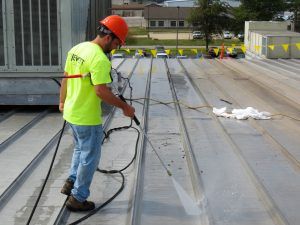 Coating preparation depends largely on what type of existing roof system is to be coated.
Coating preparation depends largely on what type of existing roof system is to be coated.
In the case of a metal roof system, the roof is inspected for loose and missing fasteners as well as any flaws in the roof system that need to be repaired prior to the application of the roof coating. On single ply membranes, the roof is inspected for failing seams, or other deficiencies in the existing roof system that may need repaired.
Repairs are made to existing roof system and the surface is thoroughly cleaned using a pressure washer, and if necessary, an additional cleaning agent to ensure proper adhesion of the roof coating.
After the preparation of the roof surface when you roof coating is applied based on the manufacturer’s recommended application techniques. Sometimes the application requires multiple layers of the roof coating.
Industrial Roof Coating Durability
The trusted roof coating manufacturers that Jewett is partnered with all have an available 10-year warranty on their roof coating products. In some cases, a 15-year warranty is available for an additional fee.
A preventative maintenance plan is highly recommended to ensure that the roof coating performs its absolute best over the duration of its life.





